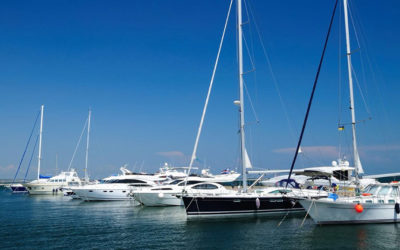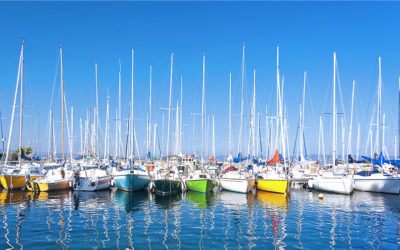The rudder is the submerged part of the helm assembly, which deflects the water flow under the hull of the boat. The pivoting of the rudder steers the boat. For an effective rudder, the helm angle is decisive. Band of Boats explains how to get the best out of this component.
1. The different types of rudder
Boats can have different types of rudder. There is the hung rudder under the overhang of the hull, the articulated rudder with a joint at the bottom, which is placed at the end of the skeg, the balanced rudder, unbalanced rudder, and semi-balanced rudder. Note that the rudder performs better when placed behind the propeller, because the water flow is accelerated in that area.
Boat builders have adapted rudders to optimise navigation manoeuvres as much as possible.
Many dinghies and racing yachts have rudders made of two articulated pieces. The fact that they can be raised facilitates beach landings and creates less drag during sailing.
Certain boatyards and amateur builders have chosen to equip their boats with twin rudders. These models provide better efficiency when the boat tilts when heeling. They can sail with just one rudder when sailing downwind to reduce drag. It also provides additional security in the event that one of the rudders is torn off by an unidentified floating object.
2. Essential components of the rudder: The helm angle and the rudder torque
The helm angle is the orientation of the rudder with respect to the longitudinal axis of the boat. Certain boats are equipped with a helm angle indicator. It reads zero degrees when the helm is aligned with the axis, and the maximum angles to the right and left. It is very useful to be aware of these readings when making complicated manoeuvres (especially in reverse).
During tacking, the helm angle must not be too open, because the rudder slows the boat considerably. Its excessive opening slows the water streams on the hull, and the boat therefore slows down.
The rudder torque is the torque required to steer. It depends on the speed of the water running along the surface of the rudder at a certain angle, its dimension, whether it is a full sweep, and its balancing surface. It is mainly the architects who confirm all these calculations.
To turn, the boat needs a deflection force on the rudder and a pivoting point (the keel or the fin).
To be effective, the rudder must maintain an optimum angle of 15 to 30 degrees. This creates laminar flow around the rudder.
The deflection force is the resultant of two forces: the drag, which is parallel to the fluid (water), and the lift, which is perpendicular to the drag.
In the context where the lift is too strong, the boat will tend to plunge into the water when sailing rapidly, whereas it should stay within its flow lines.
If the rudder is undersized, manoeuvres are less effective because they are more difficult to perform. The steering must be anticipated.
3. What is the secret to being a great helmsman?
Their handling of the tiller is what distinguishes great helmsmen. Their big secret consists of keeping the tiller aligned as much as possible with the longitudinal axis of the boat in order to avoid slowing it. Each jerk or abrupt movement tends to slow the boat. The helmsman must remain master of the ship but steer it gently, with finesse.
Tacking is the main area where improvements can be made.
In a sailing boat, tacking should be clean, but without excessive slowing. The boat’s trajectory should be as rectilinear as possible.
You now have everything you need to become an exceptional helmsman!

